Xiaoyang Li
Reinforcement Learning Optimization for Large-Scale Learning: An Efficient and User-Friendly Scaling Library
Jun 06, 2025Abstract:We introduce ROLL, an efficient, scalable, and user-friendly library designed for Reinforcement Learning Optimization for Large-scale Learning. ROLL caters to three primary user groups: tech pioneers aiming for cost-effective, fault-tolerant large-scale training, developers requiring flexible control over training workflows, and researchers seeking agile experimentation. ROLL is built upon several key modules to serve these user groups effectively. First, a single-controller architecture combined with an abstraction of the parallel worker simplifies the development of the training pipeline. Second, the parallel strategy and data transfer modules enable efficient and scalable training. Third, the rollout scheduler offers fine-grained management of each sample's lifecycle during the rollout stage. Fourth, the environment worker and reward worker support rapid and flexible experimentation with agentic RL algorithms and reward designs. Finally, AutoDeviceMapping allows users to assign resources to different models flexibly across various stages.
Towards Intelligent Edge Sensing for ISCC Network: Joint Multi-Tier DNN Partitioning and Beamforming Design
Apr 30, 2025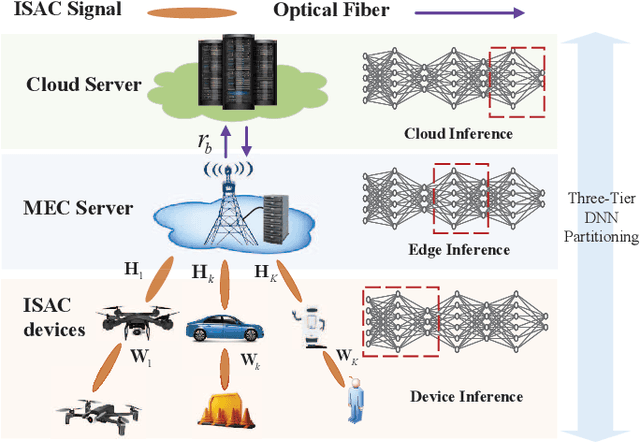
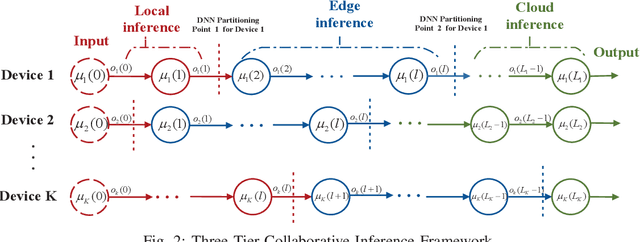

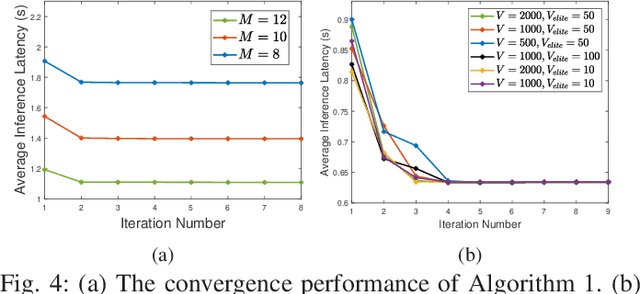
Abstract:The combination of Integrated Sensing and Communication (ISAC) and Mobile Edge Computing (MEC) enables devices to simultaneously sense the environment and offload data to the base stations (BS) for intelligent processing, thereby reducing local computational burdens. However, transmitting raw sensing data from ISAC devices to the BS often incurs substantial fronthaul overhead and latency. This paper investigates a three-tier collaborative inference framework enabled by Integrated Sensing, Communication, and Computing (ISCC), where cloud servers, MEC servers, and ISAC devices cooperatively execute different segments of a pre-trained deep neural network (DNN) for intelligent sensing. By offloading intermediate DNN features, the proposed framework can significantly reduce fronthaul transmission load. Furthermore, multiple-input multiple-output (MIMO) technology is employed to enhance both sensing quality and offloading efficiency. To minimize the overall sensing task inference latency across all ISAC devices, we jointly optimize the DNN partitioning strategy, ISAC beamforming, and computational resource allocation at the MEC servers and devices, subject to sensing beampattern constraints. We also propose an efficient two-layer optimization algorithm. In the inner layer, we derive closed-form solutions for computational resource allocation using the Karush-Kuhn-Tucker conditions. Moreover, we design the ISAC beamforming vectors via an iterative method based on the majorization-minimization and weighted minimum mean square error techniques. In the outer layer, we develop a cross-entropy based probabilistic learning algorithm to determine an optimal DNN partitioning strategy. Simulation results demonstrate that the proposed framework substantially outperforms existing two-tier schemes in inference latency.
OrchMLLM: Orchestrate Multimodal Data with Batch Post-Balancing to Accelerate Multimodal Large Language Model Training
Mar 31, 2025Abstract:Multimodal large language models (MLLMs), such as GPT-4o, are garnering significant attention. During the exploration of MLLM training, we identified Modality Composition Incoherence, a phenomenon that the proportion of a certain modality varies dramatically across different examples. It exacerbates the challenges of addressing mini-batch imbalances, which lead to uneven GPU utilization between Data Parallel (DP) instances and severely degrades the efficiency and scalability of MLLM training, ultimately affecting training speed and hindering further research on MLLMs. To address these challenges, we introduce OrchMLLM, a comprehensive framework designed to mitigate the inefficiencies in MLLM training caused by Modality Composition Incoherence. First, we propose Batch Post-Balancing Dispatcher, a technique that efficiently eliminates mini-batch imbalances in sequential data. Additionally, we integrate MLLM Global Orchestrator into the training framework to orchestrate multimodal data and tackle the issues arising from Modality Composition Incoherence. We evaluate OrchMLLM across various MLLM sizes, demonstrating its efficiency and scalability. Experimental results reveal that OrchMLLM achieves a Model FLOPs Utilization (MFU) of $41.6\%$ when training an 84B MLLM with three modalities on $2560$ H100 GPUs, outperforming Megatron-LM by up to $3.1\times$ in throughput.
Redundant feature screening method for human activity recognition based on attention purification mechanism
Mar 30, 2025Abstract:In the field of sensor-based Human Activity Recognition (HAR), deep neural networks provide advanced technical support. Many studies have proven that recognition accuracy can be improved by increasing the depth or width of the network. However, for wearable devices, the balance between network performance and resource consumption is crucial. With minimum resource consumption as the basic principle, we propose a universal attention feature purification mechanism, called MSAP, which is suitable for multi-scale networks. The mechanism effectively solves the feature redundancy caused by the superposition of multi-scale features by means of inter-scale attention screening and connection method. In addition, we have designed a network correction module that integrates seamlessly between layers of individual network modules to mitigate inherent problems in deep networks. We also built an embedded deployment system that is in line with the current level of wearable technology to test the practical feasibility of the HAR model, and further prove the efficiency of the method. Extensive experiments on four public datasets show that the proposed method model effectively reduces redundant features in filtered data and provides excellent performance with little resource consumption.
Improved Extrinsic Calibration of Acoustic Cameras via Batch Optimization
Feb 10, 2025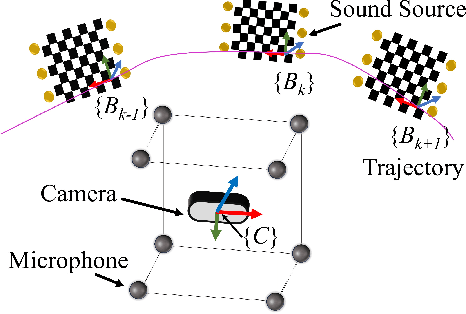
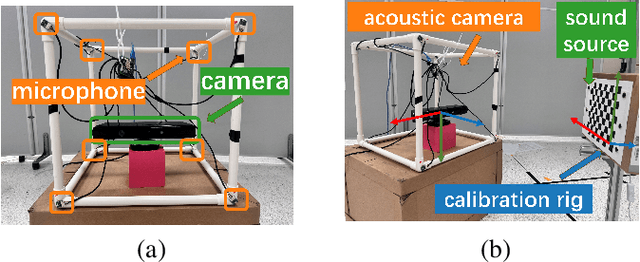
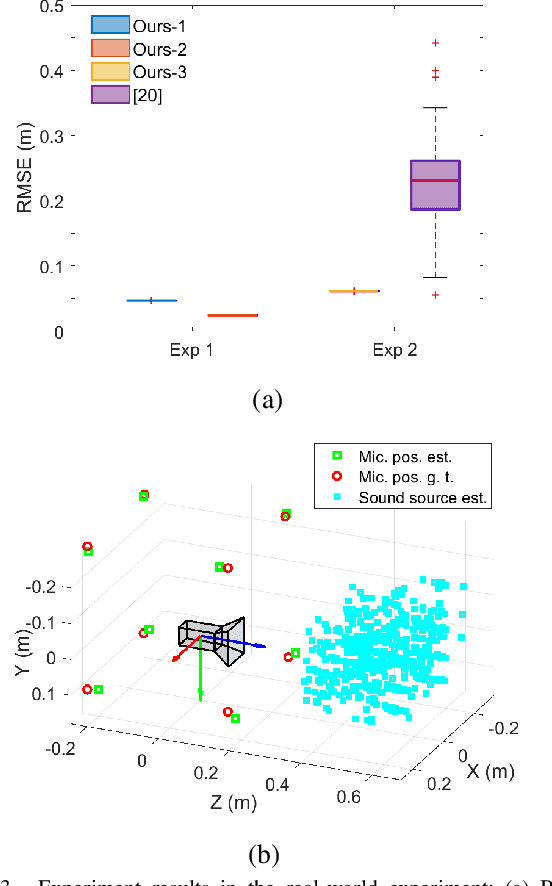
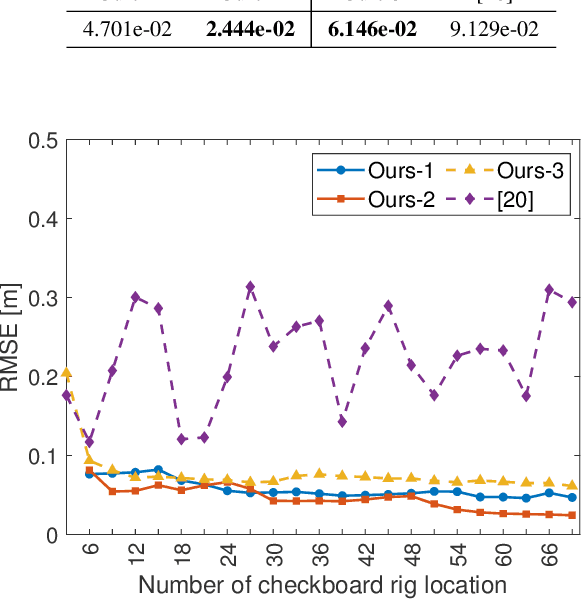
Abstract:Acoustic cameras have found many applications in practice. Accurate and reliable extrinsic calibration of the microphone array and visual sensors within acoustic cameras is crucial for fusing visual and auditory measurements. Existing calibration methods either require prior knowledge of the microphone array geometry or rely on grid search which suffers from slow iteration speed or poor convergence. To overcome these limitations, in this paper, we propose an automatic calibration technique using a calibration board with both visual and acoustic markers to identify each microphone position in the camera frame. We formulate the extrinsic calibration problem (between microphones and the visual sensor) as a nonlinear least squares problem and employ a batch optimization strategy to solve the associated problem. Extensive numerical simulations and realworld experiments show that the proposed method improves both the accuracy and robustness of extrinsic parameter calibration for acoustic cameras, in comparison to existing methods. To benefit the community, we open-source all the codes and data at https://github.com/AISLAB-sustech/AcousticCamera.
Energy-Efficient SLAM via Joint Design of Sensing, Communication, and Exploration Speed
Dec 18, 2024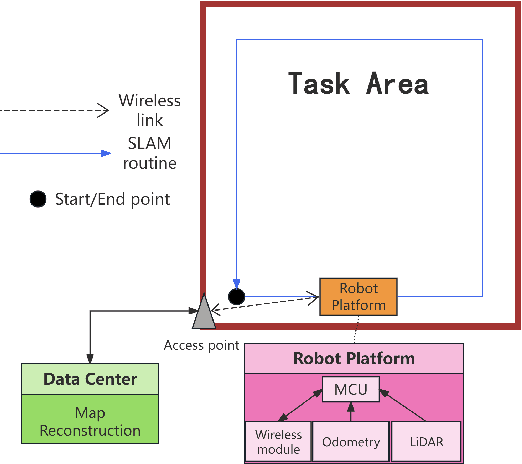

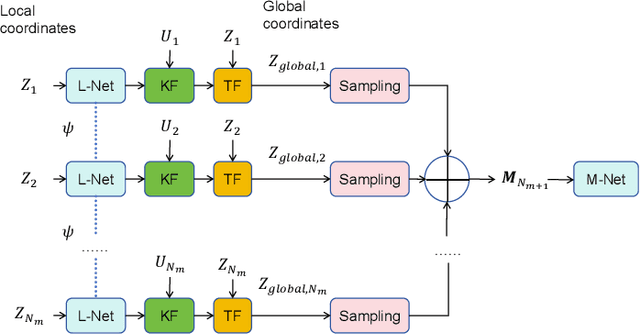
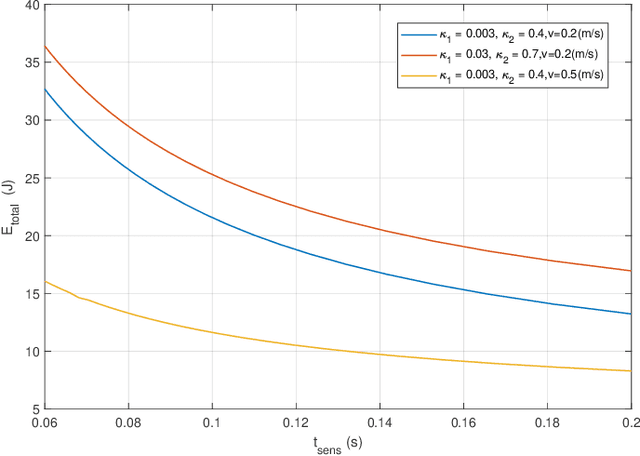
Abstract:To support future spatial machine intelligence applications, lifelong simultaneous localization and mapping (SLAM) has drawn significant attentions. SLAM is usually realized based on various types of mobile robots performing simultaneous and continuous sensing and communication. This paper focuses on analyzing the energy efficiency of robot operation for lifelong SLAM by jointly considering sensing, communication and mechanical factors. The system model is built based on a robot equipped with a 2D light detection and ranging (LiDAR) and an odometry. The cloud point raw data as well as the odometry data are wirelessly transmitted to data center where real-time map reconstruction is realized based on an unsupervised deep learning based method. The sensing duration, transmit power, transmit duration and exploration speed are jointly optimized to minimize the energy consumption. Simulations and experiments demonstrate the performance of our proposed method.
Mining Limited Data Sufficiently: A BERT-inspired Approach for CSI Time Series Application in Wireless Communication and Sensing
Dec 09, 2024



Abstract:Channel State Information (CSI) is the cornerstone in both wireless communication and sensing systems. In wireless communication systems, CSI provides essential insights into channel conditions, enabling system optimizations like channel compensation and dynamic resource allocation. However, the high computational complexity of CSI estimation algorithms necessitates the development of fast deep learning methods for CSI prediction. In wireless sensing systems, CSI can be leveraged to infer environmental changes, facilitating various functions, including gesture recognition and people identification. Deep learning methods have demonstrated significant advantages over model-based approaches in these fine-grained CSI classification tasks, particularly when classes vary across different scenarios. However, a major challenge in training deep learning networks for wireless systems is the limited availability of data, further complicated by the diverse formats of many public datasets, which hinder integration. Additionally, collecting CSI data can be resource-intensive, requiring considerable time and manpower. To address these challenges, we propose CSI-BERT2 for CSI prediction and classification tasks, effectively utilizing limited data through a pre-training and fine-tuning approach. Building on CSI-BERT1, we enhance the model architecture by introducing an Adaptive Re-Weighting Layer (ARL) and a Multi-Layer Perceptron (MLP) to better capture sub-carrier and timestamp information, effectively addressing the permutation-invariance problem. Furthermore, we propose a Mask Prediction Model (MPM) fine-tuning method to improve the model's adaptability for CSI prediction tasks. Experimental results demonstrate that CSI-BERT2 achieves state-of-the-art performance across all tasks.
LoFi: Vision-Aided Label Generator for Wi-Fi Localization and Tracking
Dec 06, 2024



Abstract:Wi-Fi localization and tracking has shown immense potential due to its privacy-friendliness, wide coverage, permeability, independence from lighting conditions, and low cost. Current methods can be broadly categorized as model-based and data-driven approaches, where data-driven methods show better performance and have less requirement for specialized devices, but struggle with limited datasets for training. Due to limitations in current data collection methods, most datasets only provide coarse-grained ground truth (GT) or limited amount of label points, which greatly hinders the development of data-driven methods. Even though lidar can provide accurate GT, their high cost makes them inaccessible to many users. To address these challenges, we propose LoFi, a vision-aided label generator for Wi-Fi localization and tracking, which can generate ground truth position coordinates solely based on 2D images. The easy and quick data collection method also helps data-driven based methods deploy in practice, since Wi-Fi is a low-generalization modality and when using relevant methods, it always requires fine-tuning the model using newly collected data. Based on our method, we also collect a Wi-Fi tracking and localization dataset using ESP32-S3 and a webcam. To facilitate future research, we will make our code and dataset publicly available upon publication.
KNN-MMD: Cross Domain Wi-Fi Sensing Based on Local Distribution Alignment
Dec 06, 2024



Abstract:As a key technology in Integrated Sensing and Communications (ISAC), Wi-Fi sensing has gained widespread application in various settings such as homes, offices, and public spaces. By analyzing the patterns of Channel State Information (CSI), we can obtain information about people's actions for tasks like person identification, gesture recognition, and fall detection. However, the CSI is heavily influenced by the environment, such that even minor environmental changes can significantly alter the CSI patterns. This will cause the performance deterioration and even failure when applying the Wi-Fi sensing model trained in one environment to another. To address this problem, we introduce a K-Nearest Neighbors Maximum Mean Discrepancy (KNN-MMD) model, a few-shot method for cross-domain Wi-Fi sensing. We propose a local distribution alignment method within each category, which outperforms traditional Domain Adaptation (DA) methods based on global alignment. Besides, our method can determine when to stop training, which cannot be realized by most DA methods. As a result, our method is more stable and can be better used in practice. The effectiveness of our method are evaluated in several cross-domain Wi-Fi sensing tasks, including gesture recognition, person identification, fall detection, and action recognition, using both a public dataset and a self-collected dataset. In one-shot scenario, our method achieves accuracy of 93.26%, 81.84%, 77.62%, and 75.30% in the four tasks respectively. To facilitate future research, we will make our code and dataset publicly available upon publication.
Adaptive Dense Reward: Understanding the Gap Between Action and Reward Space in Alignment
Oct 23, 2024
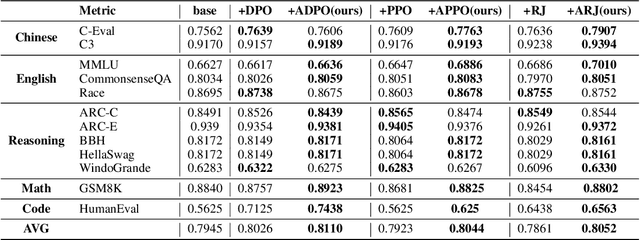
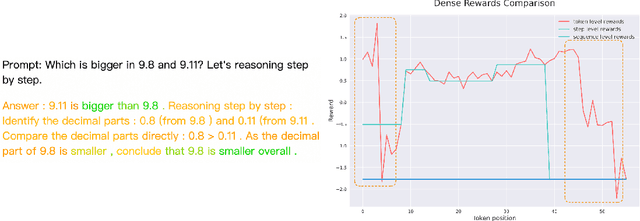
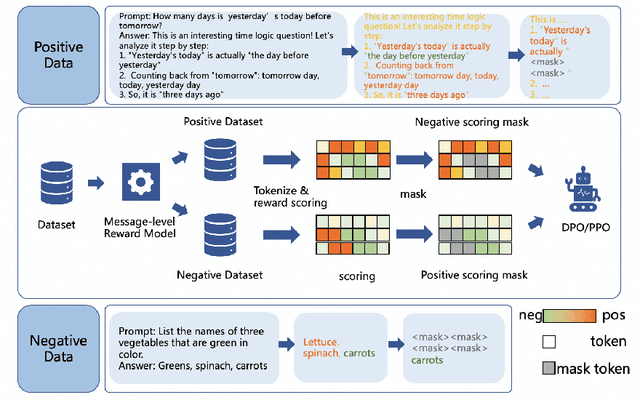
Abstract:Reinforcement Learning from Human Feedback (RLHF) has proven highly effective in aligning Large Language Models (LLMs) with human preferences. However, the original RLHF typically optimizes under an overall reward, which can lead to a suboptimal learning process. This limitation stems from RLHF's lack of awareness regarding which specific tokens should be reinforced or suppressed. Moreover, conflicts in supervision can arise, for instance, when a chosen response includes erroneous tokens, while a rejected response contains accurate elements. To rectify these shortcomings, increasing dense reward methods, such as step-wise and token-wise RLHF, have been proposed. However, these existing methods are limited to specific tasks (like mathematics). In this paper, we propose the ``Adaptive Message-wise RLHF'' method, which robustly applies to various tasks. By defining pivot tokens as key indicators, our approach adaptively identifies essential information and converts sample-level supervision into fine-grained, subsequence-level supervision. This aligns the density of rewards and action spaces more closely with the information density of the input. Experiments demonstrate that our method can be integrated into various training methods, significantly mitigating hallucinations and catastrophic forgetting problems while outperforming other methods on multiple evaluation metrics. Our method improves the success rate on adversarial samples by 10\% compared to the sample-wise approach and achieves a 1.3\% improvement on evaluation benchmarks such as MMLU, GSM8K, and HumanEval et al.
 Add to Chrome
Add to Chrome Add to Firefox
Add to Firefox Add to Edge
Add to Edge